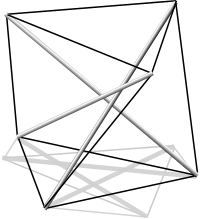Tensegrity is a portmanteau of tensional integrity. It refers to the integrity of structures as being based in a synergy between balanced tension and compression components.
The term "tensegrity" was first explored by artist Kenneth Snelson to produce sculptures such as his 18 meter high Needle Tower in 1968. The term 'tensegrity' was coined for Snelson by Buckminster Fuller. Fuller is best known for his geodesic domes, which he developed based on concepts explained and demonstrated by Snelson through sculptures. The term "synergetics" may refer more abstractly to synergetic systems of contrasting forces.
Concept

Tensegrity is the exhibited strength that results "when push and pull have a win-win relationship with each other". Tension is continuous and compression discontinuous, such that continuous pull is balanced by equivalently discontinuous pushing forces.
Buckminster Fuller explained that these fundamental phenomena were not opposites, but complements that could always be found together. Tensegrity is the name for a synergy between co-existing pairs of fundamental physical laws; of push and pull, and compression and tension, or repulsion and attraction.
If one pushes a ping-pong ball on a smooth table with the point of a sharp pencil, the ball would always roll away from the direction of the push, first rolling one way then the other. Push is divergent. On the other hand, attaching a string to the ping pong ball with tape and pulling it creates convergence. No matter how other forces might influence the ball to roll away from you, the string would always bring it to you more and more directly. Pull is convergent. Similarly, pulling a trailer uphill with a car, the trailer will converge toward the same course behind the car. If the trailer begins to sway, increasing pull by increasing acceleration can dampen the swaying motion. Driving downhill however will cause the trailer to push, and the trailer will show tendencies to sway from side to side.
The rubber skin of the balloon can be seen as continuously pushing (against the air inside) while the individual molecules of air are discontinuously pushing against the inside of the balloon keeping it inflated. All external forces striking the external surface are immediately and continuously distributed over the entire system, meaning the balloon is very strong despite its thin material. Similarly, thin plastic membranes such as plastic bags are often stronger when loaded rather than unloaded.
Metaphorical tensegrity
It should be noted that Webster's dictionary has simplified the collective meaning as "all things working together". And, while this may be seen as an "over-simplification" in lieu of the technical underpinnings that accompany this concept, the phrase is legitimate in the sense of this concept's universal applicability. The phrase aptly covers the "spirit" of the two words used in the creation of this neologism, in that the breadth & depth in its inherent meaning (semantic carriage) is extensive and multi-disciplinary.
For example, the formation of functioning architectures in one particular area of cybernetics research - sometimes referred to as "systems intellect" (the paradigmatic landscapes of the meta-cognitive level), makes use of octahedral matrices for the creation of focuses. The simplest form of tensegrity is that of the octahedron (first discovered by Theodore Pope). These matrices help to expeditiously capture the ever-changing/dynamic "contextual backdrop". So, the formation of these functioning architectures which, theoretically, allows for a kind of "auto-epistemological" approach to the creation of "sentience" in the cybernetic environment, is then dependent upon conceptually-based "primitives" held in tension - compression or complementary relationships. These architectures also allow for the ready implementation of any acquired acumen that has been "codified" as an "expert system" (the algorithmic & heuristic content found therein) relative to the perceived contextual backdrop. This would imply then that even human thought & reconnoitering dialogs have "tensegrital (adj)" underpinnings.
Applications
The idea was adopted into architecture in the 1980s when David Geiger designed the first significant structure - Seoul Olympic Gymnastics Arena for the 1988 Summer Olympics. The Georgia Dome, which was used for the 1996 Summer Olympics is a large tensegrity structure of similar design to the aforementioned Gymnastics Hall.
Theoretically, there is no limitation to the size of a tensegrity. Cities could be covered with geodesic domes. Planets and stars (Dyson sphere) could be contained within them.
"Tensegrity is a contraction of tensional integrity structuring. All geodesic domes are tensegrity structures, whether the tension-islanded compression differentiations are visible to the observer or not. Tensegrity geodesic spheres do what they do because they have the properties of hydraulically or pneumatically inflated structures."
As Harvard physician and scientist Donald Ingber explains:
"The tension-bearing members in these structures – whether Fuller's domes or Snelson's sculptures – map out the shortest paths between adjacent members (and are therefore, by definition, arranged geodesically) Tensional forces naturally transmit themselves over the shortest distance between two points, so the members of a tensegrity structure are precisely positioned to best withstand stress. For this reason, tensegrity structures offer a maximum amount of strength."
In 2009, the Kurilpa Bridge will open across the Brisbane River in Queensland, Australia. The new greenbridge will be a multiple-mast, cable-stay structure based on the principles of tensegrity.
Biology
The concept has applications in biology. Biological structures such as muscles and bones, or rigid and elastic cell membranes, are made strong by the unison of tensioned and compressed parts. The muscular-skeletal system is a synergy of muscle and bone, the muscle provides continuous pull, the bones discontinuous push. Tensegrity has been theorized by Rick Barrett to have implications in Taijiquan and athletics in general. He claims that high level athletes and Taijiquan players enter into "the zone", and have access to the tensegrity of their connective tissue system. This would explain greater levels of integration, strength, and faster reactions in elite athletes.
Russian claims
Russian artist Viatcheslav Koleichuk claimed that the idea of tensegrity was invented first by Karl Ioganson, Russian artist of Latvian descent, who contributed some works based on this principle to the main exhibition of Russian constructivism in 1921 . This claim was backed by Maria Gough in her paper "In the Laboratory of Constructivism: Karl Ioganson's Cold Structures" (October, Vol. 84, Spring, 1998, pp. 90-117). Kenneth Snelson however denied this claim insisting that Ioganson's works were much further than one step from his own concept of tensegrity.








No comments:
Post a Comment